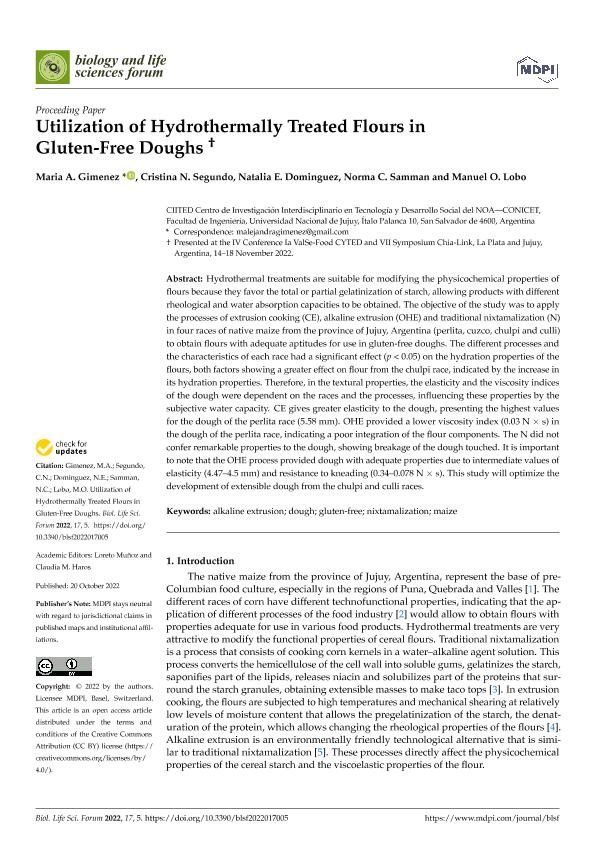Artículo
Utilization of hydrothermally treated flours in gluten-free doughs
Giménez, María Alejandra ; Segundo, Cristina Noemi
; Segundo, Cristina Noemi ; Dominguez, Natalia Ester
; Dominguez, Natalia Ester ; Samman, Norma Cristina; Lobo, Manuel Oscar
; Samman, Norma Cristina; Lobo, Manuel Oscar
 ; Segundo, Cristina Noemi
; Segundo, Cristina Noemi ; Dominguez, Natalia Ester
; Dominguez, Natalia Ester ; Samman, Norma Cristina; Lobo, Manuel Oscar
; Samman, Norma Cristina; Lobo, Manuel Oscar
Fecha de publicación:
11/2022
Editorial:
MDPI
Revista:
Biology and Life Sciences Forum
ISSN:
2673-9976
Idioma:
Inglés
Tipo de recurso:
Artículo publicado
Clasificación temática:
Resumen
Hydrothermal treatments are suitable for modifying the physicochemical properties of flours because they favor the total or partial gelatinization of starch, allowing products with different rheological and water absorption capacities to be obtained. The objective of the study was to apply the processes of extrusion cooking (CE), alkaline extrusion (OHE) and traditional nixtamalization (N) in four races of native maize from the province of Jujuy, Argentina (perlita, cuzco, chulpi and culli) to obtain flours with adequate aptitudes for use in gluten-free doughs. The different processes and the characteristics of each race had a significant effect (p < 0.05) on the hydration properties of the flours, both factors showing a greater effect on flour from the chulpi race, indicated by the increase in its hydration properties. Therefore, in the textural properties, the elasticity and the viscosity indices of the dough were dependent on the races and the processes, influencing these properties by the subjective water capacity. CE gives greater elasticity to the dough, presenting the highest values for the dough of the perlita race (5.58 mm). OHE provided a lower viscosity index (0.03 N × s) in the dough of the perlita race, indicating a poor integration of the flour components. The N did not confer remarkable properties to the dough, showing breakage of the dough touched. It is important to note that the OHE process provided dough with adequate properties due to intermediate values of elasticity (4.47?4.5 mm) and resistance to kneading (0.34?0.078 N × s). This study will optimize the development of extensible dough from the chulpi and culli races.
Palabras clave:
ALKALINE EXTRUSION
,
DOUGH
,
GLUTEN-FREE
,
NIXTAMALIZATION
Archivos asociados
Licencia
Identificadores
Colecciones
Articulos(CIITED)
Articulos de CENTRO INTERDISCIPLINARIO DE INVESTIGACIONES EN TECNOLOGIAS Y DESARROLLO SOCIAL PARA EL NOA
Articulos de CENTRO INTERDISCIPLINARIO DE INVESTIGACIONES EN TECNOLOGIAS Y DESARROLLO SOCIAL PARA EL NOA
Citación
Giménez, María Alejandra; Segundo, Cristina Noemi; Dominguez, Natalia Ester; Samman, Norma Cristina; Lobo, Manuel Oscar; Utilization of hydrothermally treated flours in gluten-free doughs; MDPI; Biology and Life Sciences Forum; 17; 11-2022; 2-6
Compartir
Altmétricas



